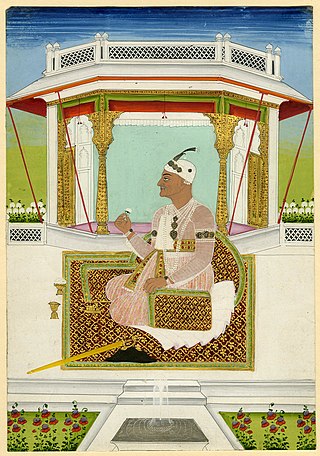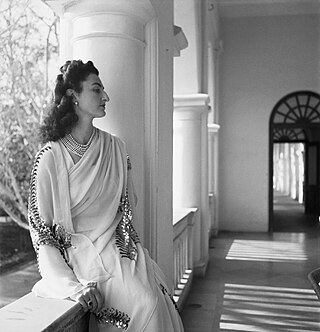Related Research Articles

Hyderabad is the capital and largest city of the Indian state of Telangana. It occupies 650 km2 (250 sq mi) on the Deccan Plateau along the banks of the Musi River, in the northern part of Southern India. With an average altitude of 542 m (1,778 ft), much of Hyderabad is situated on hilly terrain around artificial lakes, including the Hussain Sagar lake, predating the city's founding, in the north of the city centre. According to the 2011 Census of India, Hyderabad is the fourth-most populous city in India with a population of 6.9 million residents within the city limits, and has a population of 9.7 million residents in the metropolitan region, making it the sixth-most populous metropolitan area in India. With an output of US$74 billion, Hyderabad has the fifth-largest urban economy in India.

Hyderabad State, also known as Hyderabad Deccan, was a kingdom, princely state, and country, located in the south-central Deccan region of the Indian subcontinent with its capital at the city of Hyderabad. It is now divided into the present-day states of Telangana, the Kalyana-Karnataka region of Karnataka, and the Marathwada region of Maharashtra in India.

Nizam of Hyderabad was the title of the monarch of the Hyderabad State. Nizam is a shortened form of Niẓām ul-Mulk, which means Administrator of the Realm, and was the title bestowed upon Asaf Jah I when he was appointed Viceroy of the Deccan by the Mughal Emperor Farrukhsiyar. In addition to being the Mughal Viceroy (Naib) of the Deccan, Asaf Jah I was also the premier courtier of the Mughal Empire until 1724, when he established the independent monarchy of Hyderabad and adopted the title "Nizam of Hyderabad".

Mir Osman Ali Khan, Asaf Jah VII was the last Nizam (ruler) of the Princely State of Hyderabad, the largest princely state in British India. He ascended the throne on 29 August 1911, at the age of 25 and ruled the Kingdom of Hyderabad between 1911 and 1948, until India annexed it. He was styled as His Exalted Highness-(H.E.H) the Nizam of Hyderabad, and was widely considered one of the world's wealthiest people of all time. With some estimate placing his wealth at 2% of U.S. GDP, his portrait was on the cover of Time magazine in 1937. As a semi-autonomous monarch, he had his own mint, printing his own currency, the Hyderabadi rupee, and had a private treasury that was said to contain £100 million in gold and silver bullion, and a further £400 million of jewels. The major source of his wealth was the Golconda mines, the only supplier of diamonds in the world at that time. Among them was the Jacob Diamond, valued at some £50 million, and used by the Nizam as a paperweight.

Mir Nizam Ali Khan Siddiqi, Asaf Jah II was the 5th Nizam of Hyderabad State in South India between 1762 and 1803. He was born on 7 March 1734 as fourth son to Asaf Jah I and Umda Begum. His official name is Asaf Jah II, Nizam ul-Mulk, Nizam ud-Daula, Nawab Mir Nizam 'Ali Khan Siddiqi, Fateh Jang, Sipah Salar, Nawab Subedar of the Deccan. Sawānih-i-Deccan, a Persian work compiled by Munim Khan, a military commander during the era of Asaf Jah II gave more insight about administration of Asaf Jahis.

Hatice Hayriye Ayşe Dürrüşehvar Sultan, after marriage Durru Shehvar Durdana Begum Sahiba, Princess of Berar; was an Ottoman princess, the only daughter of the last caliph Abdulmejid II, who was the last heir apparent to the Ottoman Imperial throne and the last Caliph of the Ottoman Caliphate.

Nizam Mir Barkat Ali Khan Siddiqi Mukarram Jah, Asaf Jah VIII, less formally known as Mukarram Jah, was the titular Nizam of Hyderabad between 1967 and 1971. He was the head of the House of Asaf Jah until his death in 2023.

Nilüfer Hanımsultan;, nicknamed as the Kohinoor of Hyderabad, was an Ottoman princess. She was the first wife of Moazzam Jah, the second son of Mir Osman Ali Khan, the last Nizam of Hyderabad in India.

Muffakham Jah College of Engineering and Technology (MJCET) is an engineering college located at Mount Pleasant, Road number 3, Banjara Hills, in the heart of the city of Hyderabad in India. The college is named after Prince Muffakham Jah – grandson of the 7th Nizam – Mir Osman Ali Khan, who had donated part of his personal land for this educational institution.

The Jewels of the Nizams of Hyderabad State are among the largest and most expensive collection of jewels in present-day India. The jewels belonged to the Nizams. After the annexation of their kingdom by Union of India, the Nizam and his heirs were barred by the Indian government from taking the collection, claiming that it was a national treasure. After much litigation, the diamond was purchased by the Government of India from the Nizam's trust for an estimated $13 million in 1995, along with other jewels of the Nizams, and is held at the Reserve Bank of India vaults in Mumbai.

The Asaf Jahi was a Muslim dynasty that ruled the Hyderabad State. The family came to India in the late 17th century and became employees of the Mughal Empire. They were great patrons of Persian culture, language, and literature, and the family found ready patronage.

Banjara Hills is an urban commercial centre and one of the most affluent neighbourhoods in Hyderabad, Telangana, India. This is an upmarket locality close to Jubilee Hills. This area was a hilly forest and was least inhabited in the past. Only few royal members of the Nizam's dynasty lived here, which was a hunting ground for them. Even with its history and status, this area now has completely been transformed to an urban commercial centre consisting of an array of high-end hotels, restaurants, night clubs and office buildings of global corporations. Banjara Hills is segregated by its road numbers, with each road having its own importance: the numbers start from 1 and end at 14.

Colonel Muffakham Jah Nawab Walashan Sahebzada Mir Karamath Ali Khan Siddiqi Bayafendi Bahadur is a member of House of Asaf Jah. He is the son of Prince Azam Jah and Dürrüşehvar Sultan. He is the grandson of both Osman Ali Khan, the seventh and final Nizam of Hyderabad, and Abdulmejid II, the last Ottoman caliph.

The culture of Hyderabad, also known as Hyderabadi Tehzeeb or Dakhini Tehzeeb, is the traditional cultural lifestyle of the Telugu people and Hyderabadi Muslims, and characterizes distinct linguistic and cultural traditions of North and South India, which meet and mingle in the city and erstwhile kingdom. This blending was the result of the geographic location of the region and the variety of historical dynasties that ruled the city across different periods—its inception by the Qutub Shahi dynasty in 1591 AD, the occupation by the Mughal Empire and its decline, and the patronage under the Asaf Jahi dynasty.
H.E.H. The Nizam’s Charitable Trust is a non-profit organization. It is currently headed by Prince Muffakham Jah - the grandson of 7th Nizam Mir Osman Ali Khan. The trust grants scholarships to around 2000 students every year. The beneficiaries include students belonging to states of Andhra Pradesh and Telangana from 5th to 10th class, intermediate level, and degree students.
The localities and neighborhoods of Hyderabad have unique oral histories, dating to the time of the Qutb Shahi dynasty, over 400 years ago, and are named after various people and things. Some are named after a major building or structure in the locality, others named for individuals. The names are mostly in Telugu and Urdu, the major languages of the city. This is a list of localities, neighborhoods and streets of Hyderabad and their etymology.
Mir Najaf Ali Khan is a grandson of the last Nizam of Hyderabad, Mir Osman Ali Khan. He manages a few trusts of the last Nizam, including the Nizam's Trust.
The Sultan-ul-Uloom Education Society is a non-profit organisation based in Hyderabad, India, which aimed at providing quality education to minority students. It runs several educational institutions in the city.
References
- ↑ "Unveiling the past". The Times of India . Archived from the original on 21 February 2013. Retrieved 13 March 2012.
- ↑ "City Museum depicting Hyderabad's history inaugurated". Zee News. Retrieved 13 March 2012.
- ↑ "Muffakham Jah opens City Museum". The Hindu. Retrieved 13 March 2012.